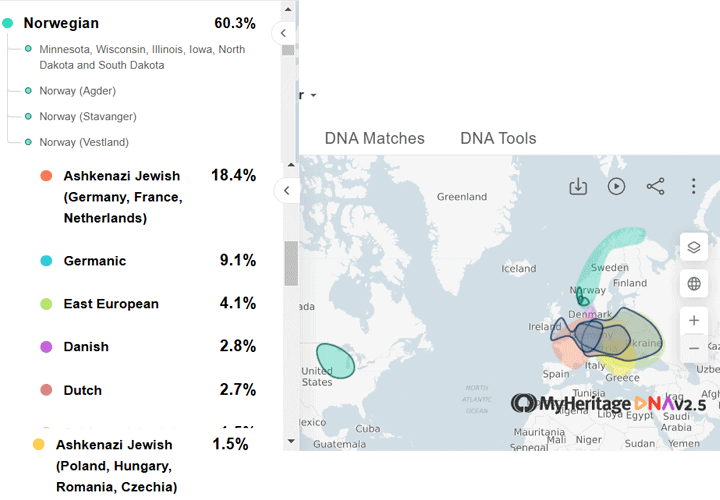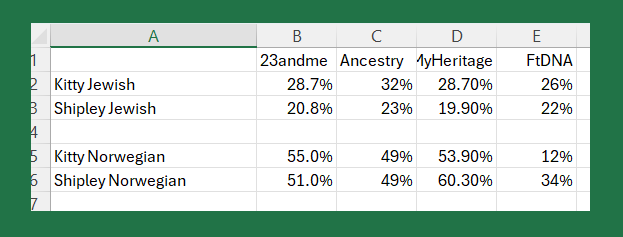All the DNA testing companies are still refining and improving their bio-ancestry estimates (which they call ethnicity). They are getting closer to agreeing with each other now, but that aspect of DNA testing is not yet a firm science. A number of companies have recently updated their estimates. Ancestry did a major update in October 2024 (click here for that white paper) and MyHeritage just did an update as well. The main effect on my family’s results is a far more accurate prediction of our Norwegian percentage. In the past, all the companies, except Ancestry, called our Norwegian Scandinavian and English. MyHeritage even gets the locations in Norway correct, since we have ancestors from 3 different areas. This is due to my grandad, born in Kristiansand, marrying the daughter of Norwegian immigrants (from Vestland and Hordaland) who met in Brooklyn.

Above are my brother’s current estimates with the new MyHeritage update. Since we have one German Jewish grandfather, I love to see how much each company assigns to Ashkenazi (northern European Jewish) for me and my brother. They all agree that I got about 8% more from our grandad than he did, but the exact amounts are different. Plus MyHeritage now breaks the Ashkenazi into Western and Eastern Europe. My brother got those refinements (added in to Jewish below) but I did not.

Our various bio-ancestries, note Family Tree DNA is actually called Scandinavian not Norwegian. Also the extra jewish regions for MyHeritage have been added back in.
In the past MyHeritage showed only 44% Scandinavian and 27% English/Irish/Scottish which did not fit with the fact that my Dad is Norwegian going back to the 1500s. Now they show me with 53% Norwegian and no British. Ancestry has long since gotten rid of the erroneous British etc. prediction (it’s now 1%) while Family Tree DNA still has that. Yes my ancestors visited the British Isles and undoubtedly left some genetic material … While he was still alive my Dad did a 23andme test and they predict 97.3 Scandinavian for him with the rest Finnish. Unlike MyHeritage and Ancestry, 23andme does not break down Scandinavian by country.
I have a previous blog post (click here) about our ethnicity percentages where I remind my readers that “Although you inherit half of your DNA from each parent, they do not have to pass you an equal amount from each of their parents.” As you can see above, my brother and I got different amounts from our Jewish grandfather.
As the experienced tester knows, it’s the relative matching where the companies excel, although the exact relationships of more distant relatives cannot be accurately predicted. Even close family relationships, like uncle versus half brother versus grandad, are not always clear. (Click here for my post on that). Looking at that person’s relationships to other family members plus age and location can often get you to an answer.
A key feature that all the companies have is what matches you share with a specific match. Better yet is the information on how the common match is related to not just you, but also to the new match. Sometimes you have already figured out how their sibling or parent is related to you, so can put them in your tree. On Ancestry, you need the Pro Tools for this feature (click here for my posts on this) . [UPDATE: 12-Feb-2025] Family Tree DNA now gives you this functionality via their matrix tool per Roberta Estes- click here for her article.
Currently MyHeritage and GEDmatch have the best tools for exploring a DNA match in detail: chromosome browsers, clustering, and triangulation, but both have much smaller databases than Ancestry. I have many article about those tools on this blog, just ask google or use the cloud tag in the right hand column.
There once was a chromosome browser at 23andme but after a major break-in, it was removed (click here for that post). When looking at a 23andme cousin match, clicking on the DNA details shows only the percentage. This can be converted to number of centimorgans with the DNApainter online calculator. That is a terrific tool which shows you a good visualization of the possibilities, plus you can click any box to see a bar chart of frequencies. However if you are from an endogamous group like European Jewish, Mennonite, or Polynesian, you also need to have the longest segment information or the number of segments to know when a match is significant.
The relatives list at 23andme does at least show the number of segments which the DNA-sci calculator can use to give an idea of the frequency of various relationships. That calculator even separates its predictions into maternal and paternal, since the segment sizes are smaller on the maternal side due to how that recombination works. Ancestry also does well with relative matching for endogamous groups due to its Timber algorithm which removes matching segments deemed to be specific to that population. Click here for their recent white paper on how they do the DNA relative matching.
All the DNA testing companies tend to announce their new features at the yearly Rootstech conference in Salt Lake City in March, sponsored by the LDS church, which has a free online attendance option.
As to the future of 23andme , there is much uncertainty. Their focus seems to be more and more on medical research. Check their news releases occasionally for updates. Here are a few recent ones:
- New Board: https://23andme.gcs-web.com/news-releases/news-release-details/23andme-appoints-three-new-independent-directors-board
- Restructuring: https://23andme.gcs-web.com/news-releases/news-release-details/23andme-announces-business-restructuring-streamline-operations
To summarize, I recommend doing your DNA testing at Ancestry and then uploading that result to GEDmatch and MyHeritage for further analysis. If health results are of interest, also upload to Prometheuse for more analysis. However, 23andme tests more health related SNPS and explains some of those results in easy to read formats; so test there if your main interest is the medical risks in your DNA. By the way, both Ancestry and 23andme do not take DNA result uploads from other companies while the others do.

Nice summary.
As you know, I have always been wary of automatic calculators and remain so today.
Thanks Israel and wise of you to be wary. I consider them guidance.
Pingback: Friday’s Family History Finds | Empty Branches on the Family Tree
Excellent read Kitty. Thank you.
Brock Shamberg
Great summary.
My main problem area required proper separation of Cornish from other British. Ancestry has now done that. And MyHeritage (although they call it Breton). That just helped me solve a suspected NPE several generations back. Matches suggest some Scandinavian input into my Silesians about 250 years ago, but the shuffling of Scandinavian quantities and subdivisions is not helping.
One ethnicity region mis-attribution I managed to puzzle out through looking through historic movement of peoples across Europe. Half my ancestors are from Silesia/Wielkopolska and this seems to be a real melting pot of different kinds of Slavs and Germans. I have seen Americans with some resolution at Ancestry through what they now call “Ancestral Journeys”, and can’t wait to see it extended.
Yes, it has been getting better. But we still need to be clever, informed and resourceful consumers.
Charles, please tell me more about MH and Breton. I was assuming French dna to England. Am I wrong headed about that? My new MH ethnicity notes 3% Breton. My newest Brit line is from the Hampshire area. Older one in Devon who were very early into the colonies in 1660. Lots of Scots and Scots/Irish otherwise. Rather rare MT DNA to Scotland.
Bill
Why did you not recommend testing at FTDNA?
Linda, it depends on what your goals are. The average tester will be happiest if they test at Ancestry. The more interested user can then upload elsewhere including ftDNA.
Family Tree DNA has the smallest database and the fewest tools but it saves the samples for 25 years and uses cheek swabbing which is good for older people.
For a more detailed comparison of the testing companies see this page of mine https://blog.kittycooper.com/dna-basics/dna-testing/
Kitty
I love your blog. Thank you for all you do!!!